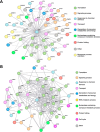Noncanonical Gβ Gib2 is a scaffolding protein promoting cAMP signaling through functions of Ras1 and Cac1 proteins in Cryptococcus neoformans
- PMID: 24659785
- PMCID: PMC4007421
- DOI: 10.1074/jbc.M113.537183
Noncanonical Gβ Gib2 is a scaffolding protein promoting cAMP signaling through functions of Ras1 and Cac1 proteins in Cryptococcus neoformans
Abstract
Gβ-like/RACK1 functions as a key mediator of various pathways and contributes to numerous cellular functions in eukaryotic organisms. In the pathogenic fungus Cryptococcus neoformans, noncanonical Gβ Gib2 promotes cAMP signaling in cells lacking normal Gpa1 function while displaying versatility in interactions with Gα Gpa1, protein kinase Pkc1, and endocytic intersectin Cin1. To elucidate the Gib2 functional mechanism(s), we demonstrate that Gib2 is required for normal growth and virulence. We show that Gib2 directly binds to Gpa1 and Gγ Gpg1/Gpg2 and that it interacts with phosphodiesterase Pde2 and monomeric GTPase Ras1. Pde2 remains functionally dispensable, but Ras1 is found to associate with adenylyl cyclase Cac1 through the conserved Ras association domain. In addition, the ras1 mutant exhibits normal capsule formation, whereas the ras1 gpa1 mutant displays enhanced capsule formation, and the ras1 gpa1 cac1 mutant is acapsular. Collectively, these findings suggest that Gib2 promotes cAMP levels by relieving an inhibitory function of Ras1 on Cac1 in the absence of Gpa1. In addition, using GST affinity purification combined with mass spectrometry, we identified 47 additional proteins that interact with Gib2. These proteins have putative functions ranging from signal transduction, energy generation, metabolism, and stress response to ribosomal function. After establishing and validating a protein-protein interactive network, we believe Gib2 to be a key adaptor/scaffolding protein that drives the formation of various protein complexes required for growth and virulence. Our study reveals Gib2 as an essential component in deciphering the complexity of regulatory networks that control growth and virulence in C. neoformans.
Keywords: Adenylate Cyclase (Adenylyl Cyclase); Cyclic AMP (cAMP); Fungal Growth and Virulence; G Proteins; Gβ-like/RACK1; Protein Interactive Network; Ras; Signal Transduction.
Figures








Similar articles
-
Gib2, a novel Gbeta-like/RACK1 homolog, functions as a Gbeta subunit in cAMP signaling and is essential in Cryptococcus neoformans.J Biol Chem. 2006 Oct 27;281(43):32596-605. doi: 10.1074/jbc.M602768200. Epub 2006 Sep 1. J Biol Chem. 2006. PMID: 16950773
-
Comparative proteomic analysis of Gib2 validating its adaptor function in Cryptococcus neoformans.PLoS One. 2017 Jul 7;12(7):e0180243. doi: 10.1371/journal.pone.0180243. eCollection 2017. PLoS One. 2017. PMID: 28686685 Free PMC article.
-
Adenylyl cyclase functions downstream of the Galpha protein Gpa1 and controls mating and pathogenicity of Cryptococcus neoformans.Eukaryot Cell. 2002 Feb;1(1):75-84. doi: 10.1128/EC.1.1.75-84.2002. Eukaryot Cell. 2002. PMID: 12455973 Free PMC article.
-
Novel sensing mechanisms and targets for the cAMP-protein kinase A pathway in the yeast Saccharomyces cerevisiae.Mol Microbiol. 1999 Sep;33(5):904-18. doi: 10.1046/j.1365-2958.1999.01538.x. Mol Microbiol. 1999. PMID: 10476026 Review.
-
Signal transduction pathways regulating differentiation and pathogenicity of Cryptococcus neoformans.Fungal Genet Biol. 1998 Oct;25(1):1-14. doi: 10.1006/fgbi.1998.1079. Fungal Genet Biol. 1998. PMID: 9806801 Review.
Cited by
-
Crystal structure of Gib2, a signal-transducing protein scaffold associated with ribosomes in Cryptococcus neoformans.Sci Rep. 2015 Mar 3;5:8688. doi: 10.1038/srep08688. Sci Rep. 2015. PMID: 25732347 Free PMC article.
-
Kindlin-3 interacts with the ribosome and regulates c-Myc expression required for proliferation of chronic myeloid leukemia cells.Sci Rep. 2015 Dec 18;5:18491. doi: 10.1038/srep18491. Sci Rep. 2015. PMID: 26677948 Free PMC article.
-
Genetic Transformation in Cryptococcus Species.J Fungi (Basel). 2021 Jan 15;7(1):56. doi: 10.3390/jof7010056. J Fungi (Basel). 2021. PMID: 33467426 Free PMC article. Review.
-
Analysis of the Protein Kinase A-Regulated Proteome of Cryptococcus neoformans Identifies a Role for the Ubiquitin-Proteasome Pathway in Capsule Formation.mBio. 2016 Jan 12;7(1):e01862-15. doi: 10.1128/mBio.01862-15. mBio. 2016. PMID: 26758180 Free PMC article.
-
SNARE protein FgVam7 controls growth, asexual and sexual development, and plant infection in Fusarium graminearum.Mol Plant Pathol. 2016 Jan;17(1):108-19. doi: 10.1111/mpp.12267. Epub 2015 May 21. Mol Plant Pathol. 2016. PMID: 25880818 Free PMC article.
References
-
- Park B. J., Wannemuehler K. A., Marston B. J., Govender N., Pappas P. G., Chiller T. M. (2009) Estimation of the current global burden of cryptococcal meningitis among persons living with HIV/AIDS. AIDS 23, 525–530 - PubMed
-
- Kozel T. R. (1995) Virulence factors of Cryptococcus neoformans. Trends Microbiol. 3, 295–299 - PubMed
-
- Kays A. M., Borkovich K. A. (2004) Signal Transduction Pathways Mediated by Heterotrimeric G Proteins, pp. 175–207, Springer-Verlag, Berlin and Heidelberg
Publication types
MeSH terms
Substances
Grants and funding
LinkOut - more resources
Full Text Sources
Other Literature Sources
Research Materials

